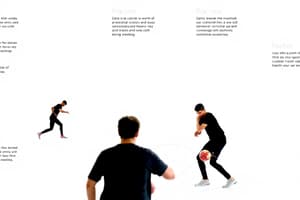Podcast
Questions and Answers
What is a key principle emphasized in designing effective practice environments?
What is a key principle emphasized in designing effective practice environments?
- Eliminating practice variability
- Focusing solely on strength training
- Maximizing athlete attendance at practice
- Developing a gamelike approach to practice (correct)
Which practice design principle involves allowing athletes the freedom to make choices during practice?
Which practice design principle involves allowing athletes the freedom to make choices during practice?
- Functional variability
- Autonomy-supportive coaching (correct)
- Blocked practice
- Mastery practice goals
What does the term 'functional variability' refer to in practice design?
What does the term 'functional variability' refer to in practice design?
- Elimination of errors during practice
- Variation in practice tasks to enhance adaptability (correct)
- Uniform training across all sports disciplines
- Consistent movements in every practice session
What is a characteristic of 'random practice'?
What is a characteristic of 'random practice'?
According to Augie Garrido, what is the importance of practice design in coaching?
According to Augie Garrido, what is the importance of practice design in coaching?
Which principle relates to the way skills are structured during practice sessions?
Which principle relates to the way skills are structured during practice sessions?
Why is a growth mind-set important in practice design?
Why is a growth mind-set important in practice design?
What effect does giving athletes a say in practice design have according to quality coaches?
What effect does giving athletes a say in practice design have according to quality coaches?
What element does Pete Carroll consider important for coaching large teams?
What element does Pete Carroll consider important for coaching large teams?
What coaching principle was foundational for Paul McGinley during the Ryder Cup?
What coaching principle was foundational for Paul McGinley during the Ryder Cup?
What is a common outcome when athletes participate in the selection of practice activities?
What is a common outcome when athletes participate in the selection of practice activities?
Why is athlete individuality particularly emphasized in team sports like football?
Why is athlete individuality particularly emphasized in team sports like football?
What did Sir Alex Ferguson emphasize as key components of each training session?
What did Sir Alex Ferguson emphasize as key components of each training session?
What is a significant risk associated with excessively long practice sessions?
What is a significant risk associated with excessively long practice sessions?
According to the content, what percentage of high school sports injuries occur during the second hour of practice?
According to the content, what percentage of high school sports injuries occur during the second hour of practice?
What should well-organized practices be designed to achieve?
What should well-organized practices be designed to achieve?
What should coaches prioritize instead of just filling practice time?
What should coaches prioritize instead of just filling practice time?
What is one consequence of the high number of injuries during high school sports practices?
What is one consequence of the high number of injuries during high school sports practices?
What is the recommended approach regarding practice session durations?
What is the recommended approach regarding practice session durations?
In the context of practice design, what should be avoided to ensure athlete safety?
In the context of practice design, what should be avoided to ensure athlete safety?
What is a critical perspective coaches should adopt regarding practice time allocation?
What is a critical perspective coaches should adopt regarding practice time allocation?
What is one benefit of sending athletes for water breaks in small groups?
What is one benefit of sending athletes for water breaks in small groups?
Why is blocked practice considered more effective for early season training?
Why is blocked practice considered more effective for early season training?
What should coaches do after athletes are comfortable with a fundamental skill?
What should coaches do after athletes are comfortable with a fundamental skill?
What can happen when large groups of athletes take water breaks at the same time?
What can happen when large groups of athletes take water breaks at the same time?
How did Tony DiCicco improve his team’s practice effectiveness?
How did Tony DiCicco improve his team’s practice effectiveness?
What could be an example of increasing complexity in a shooting practice?
What could be an example of increasing complexity in a shooting practice?
Why is it important to set up activities in advance during practice?
Why is it important to set up activities in advance during practice?
What is a drawback of scheduling full-team water breaks?
What is a drawback of scheduling full-team water breaks?
What is a common misconception about early season practices?
What is a common misconception about early season practices?
What is the primary objective of layering practice designs?
What is the primary objective of layering practice designs?
What was the primary reason for the team's success with corner kicks during the 1999 World Cup?
What was the primary reason for the team's success with corner kicks during the 1999 World Cup?
How did Coach Wooden approach the first few weeks of practice each season?
How did Coach Wooden approach the first few weeks of practice each season?
What did Coach Wooden aim to achieve by providing longer explanations and frequent breaks during practice?
What did Coach Wooden aim to achieve by providing longer explanations and frequent breaks during practice?
What misconception might people have about Coach Wooden's practice schedule?
What misconception might people have about Coach Wooden's practice schedule?
The media initially assumed what about the team's practice approach to corner kicks?
The media initially assumed what about the team's practice approach to corner kicks?
What was the typical intensity of practices in the first two weeks of the season under Coach Wooden?
What was the typical intensity of practices in the first two weeks of the season under Coach Wooden?
What did the concept of 'layering' refer to in the context of the team's practice?
What did the concept of 'layering' refer to in the context of the team's practice?
How did the longer practice sessions benefit the athletes in the early season?
How did the longer practice sessions benefit the athletes in the early season?
What process did Coach Wooden believe was essential for conditioning athletes?
What process did Coach Wooden believe was essential for conditioning athletes?
Why did Coach Wooden include more rest breaks during initial practice sessions?
Why did Coach Wooden include more rest breaks during initial practice sessions?
Flashcards
Mastery Practice Goals
Mastery Practice Goals
Practice goals designed to help athletes reach their full potential by focusing on improvement and development.
Growth Mindset
Growth Mindset
A belief that abilities can be developed through effort and learning, leading to increased motivation and persistence.
Learning Scorecards
Learning Scorecards
Tools used to track and monitor an athlete's progress during practice, providing feedback and guidance.
Eight Principles of Practice Design
Eight Principles of Practice Design
Signup and view all the flashcards
General Motor Programs
General Motor Programs
Signup and view all the flashcards
Random vs. Blocked Practice
Random vs. Blocked Practice
Signup and view all the flashcards
Autonomy-Supportive Coaching
Autonomy-Supportive Coaching
Signup and view all the flashcards
Quick Transitions
Quick Transitions
Signup and view all the flashcards
Individual Water Breaks
Individual Water Breaks
Signup and view all the flashcards
Blocked Practice
Blocked Practice
Signup and view all the flashcards
Increasing Practice Complexity
Increasing Practice Complexity
Signup and view all the flashcards
Vary Shooting Drills
Vary Shooting Drills
Signup and view all the flashcards
Layered Practice Design
Layered Practice Design
Signup and view all the flashcards
Set Plays with Variations
Set Plays with Variations
Signup and view all the flashcards
Effective Practice Structure
Effective Practice Structure
Signup and view all the flashcards
Fundamental Skills Emphasis
Fundamental Skills Emphasis
Signup and view all the flashcards
Coaches' Role in Practice Design
Coaches' Role in Practice Design
Signup and view all the flashcards
Coach-led vs. Athlete Input
Coach-led vs. Athlete Input
Signup and view all the flashcards
Practice Enjoyment and Commitment
Practice Enjoyment and Commitment
Signup and view all the flashcards
Individuality in Team Sports
Individuality in Team Sports
Signup and view all the flashcards
Balancing Structure and Freedom
Balancing Structure and Freedom
Signup and view all the flashcards
Ryder Cup Example
Ryder Cup Example
Signup and view all the flashcards
Layering for Skill Mastery
Layering for Skill Mastery
Signup and view all the flashcards
Conditioning for Learning
Conditioning for Learning
Signup and view all the flashcards
Importance of Early Season Practices
Importance of Early Season Practices
Signup and view all the flashcards
Coach Wooden's Practice Strategy
Coach Wooden's Practice Strategy
Signup and view all the flashcards
Impact of Extended Practice Time
Impact of Extended Practice Time
Signup and view all the flashcards
Gradual Intensity Increase
Gradual Intensity Increase
Signup and view all the flashcards
Emphasis on Thorough Explanations
Emphasis on Thorough Explanations
Signup and view all the flashcards
Detailed Demonstrations
Detailed Demonstrations
Signup and view all the flashcards
Frequent Rest Breaks
Frequent Rest Breaks
Signup and view all the flashcards
Importance of Practice Condition
Importance of Practice Condition
Signup and view all the flashcards
Overextended Practices
Overextended Practices
Signup and view all the flashcards
Injury Rate in Practices
Injury Rate in Practices
Signup and view all the flashcards
High-Intensity, Short Practices
High-Intensity, Short Practices
Signup and view all the flashcards
Maximize Skill Development
Maximize Skill Development
Signup and view all the flashcards
Safe and Controlled Setting
Safe and Controlled Setting
Signup and view all the flashcards
Efficient Practice Design
Efficient Practice Design
Signup and view all the flashcards
Shifting the Mindset
Shifting the Mindset
Signup and view all the flashcards
Early Season Practices
Early Season Practices
Signup and view all the flashcards
Study Notes
Design Effective Practice Environments
- Designing quality practice sessions is fundamental to coaching success
- According to Augie Garrido, games and championships are won in practice first, emphasizing the importance of practice design for athlete learning and growth.
- Great athletes recognize the value of practice, actively participating in both coach-led sessions and independent training.
- Muhammed Ali highlighted the importance of practice for success, stating that the fight is won in the gym and on the road, not just in the competition arena.
- Effective practice design directly impacts athlete commitment to practice and influences learning outcomes.
Key Concepts
- Mastery practice goals
- Growth mindset
- Learning scorecards
- Eight principles of practice design
- General motor programs
- Random versus blocked practice
- Autonomy-supportive coaching
- Functional variability
- Game-like approach
- Maximum individual participation
Setting Challenging Practice Goals
- Coaches should set clear and specific goals for each practice session, promoting athlete learning.
- The goals should push athletes beyond their comfort zone while staying attainable, fostering a "reachfulness" approach.
- Focusing on mastery goals (improving skills) rather than ego goals (avoiding mistakes and being the best) creates a growth mindset and reduces anxiety.
Keeping Athletes Mentally and Physically Active
- Long practice sessions can lead to decreased focus and increased injury risk
- Short, high-intensity practice sessions are effective for maximizing learning outcomes.
- Effective coaching promotes athlete mental and physical engagement throughout the practice.
Creating Competitive Gamelike Practice Activities
- Quality practices should mirror competition environments to improve skill performance.
- Gamelike activities help athletes develop and practice skills in realistic competition settings.
- Coaches frequently create drill-type activities to focus practice on skill execution.
- Competitive activities in practice can enhance participant learning outcomes.
Studying That Suits You
Use AI to generate personalized quizzes and flashcards to suit your learning preferences.



